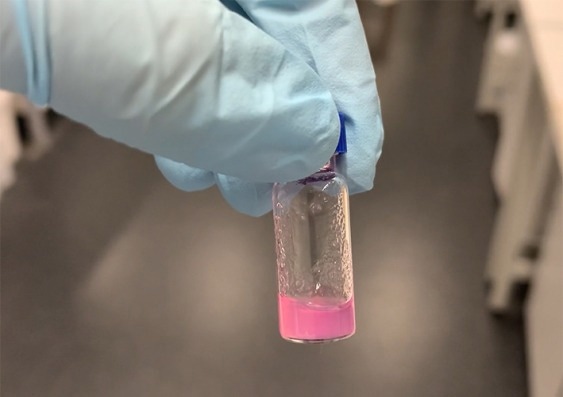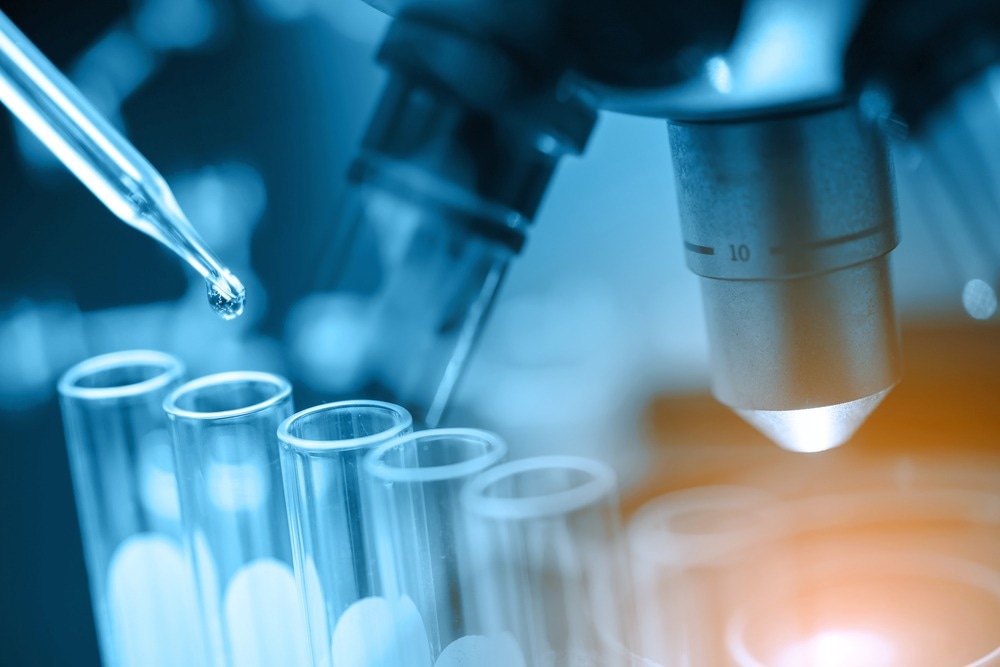Reviewed by Danielle Ellis, B.Sc.Oct 24 2023
A recently developed laboratory-created material imitates human tissue and has the potential to decrease or substitute for the utilization of animal-derived components in biomedical studies.
 The “Trpzip” material will reform after being squished, fractured, or after being expelled from a syringe. Image Credit: The University of New South Wales Sydney.
The “Trpzip” material will reform after being squished, fractured, or after being expelled from a syringe. Image Credit: The University of New South Wales Sydney.
Researchers at the University of New South Wales Sydney (UNSW) have developed a novel material with the potential to revolutionize the cultivation of human tissue in laboratory settings and its application in medical procedures.
This new material falls under the category of hydrogels, which are akin to the soft, pliable substances that exist in all living organisms, including animal cartilage and plant-based substances like seaweed. Hydrogels possess remarkable properties that render them invaluable in biomedical research by closely mimicking human tissue, thereby facilitating cell growth in a laboratory environment.
Hydrogels, both natural and human-made, have diverse applications, ranging from everyday consumer products like food and cosmetics to specialized uses such as contact lenses and absorbent materials.

Image Credit: totojang1977/Shutterstock.com
More recently, they have been employed in medical research to seal wounds and replace damaged tissue. While synthetic hydrogels have performed adequately as tissue growth scaffolds, they have been limited in replicating the intricate characteristics of actual human tissue.
However, in a recent publication in Nature Communications, scientists from UNSW describe a novel lab-engineered hydrogel that emulates the properties of natural tissue, displaying a range of surprising attributes with profound implications for medical, food, and manufacturing technology.
Associate Professor Kris Kilian, affiliated with both UNSW's School of Materials Science & Engineering and School of Chemistry, explains that the hydrogel material is crafted from uncomplicated, brief peptides, the fundamental constituents of proteins.
The material is bioactive, which means that encapsulated cells behave as if they are living in natural tissue. At the same time, the material is antimicrobial, meaning that it will prevent bacterial infections.”
Kris Kilian, Associate Professor, School of Materials Science & Engineering and School of Chemistry, The University of New South Wales
Kilian added, “This combination lands it in the sweet spot for materials that might be useful in medicine. The material is also self-healing, which means that it will reform after being squished, fractured, or after being expelled from a syringe. This makes it ideal for 3D bioprinting, or as an injectable material for medicine.”
Surprise Discovery in Lockdown
In the midst of the COVID-19 lockdown, Ashley Nguyen, a doctoral candidate at the UNSW School of Chemistry and the leading contributor to the research, stumbled upon a remarkable revelation while conducting computer simulations.
Initially, Ms Nguyen was exploring the phenomenon of molecules engaging in self-assembly, a process in which they spontaneously arrange themselves without external intervention.
It was during this investigation that she fortuitously uncovered the concept of “tryptophan zippers”—brief sequences of amino acids containing multiple tryptophan residues that act like zippers, facilitating self-assembly. These structures have since been coined as “Trpzip.”
I was excited to identify a unique peptide sequence using computational simulations that might form a hydrogel. After we returned to the lab, I synthesized the top candidate and was thrilled to see it actually form a gel.”
Ashley Nguyen, Study First Author and PhD Student, School of Chemistry, The University of New South Wales
Ms Nguyen suggests that the introduction of this hydrogel shows potential as an ethical replacement for frequently utilized natural materials.
“Natural hydrogels are used all over in society—from food processing to cosmetics—but require harvest from animals which poses ethical concerns.”
Ashley Nguyen, Study First Author and PhD Student, School of Chemistry, The University of New South Wales
Nguyen added, “Also, animal-derived materials are problematic for use in humans because of the negative immune response that occurs. With Trpzip, we have a synthetic material that not only shows potential in many areas where natural materials are currently used but also could outperform them in others, such as clinical research.”
Real World Results
To evaluate the applicability of Trpzip in biomedical research, A/Prof. Kilian's team collaborated with Dr Shafagh Waters, a researcher in the School of Biomedical Sciences at UNSW Sydney. Dr Waters utilizes Matrigel, a hydrogel derived from mouse tumors, for growing patient tissue in her research attempts.
“Matrigel has some disadvantages in research use because every batch is different. A chemically defined alternative could be cheaper and more uniform, which would prove highly beneficial to biomedical research,” states Dr Waters.
A/Professor Kilian observes that the natural materials industry is a multi-billion-dollar sector and expresses the team’s eagerness to investigate avenues for commercializing their findings.
We think that Trpzip hydrogels and materials like it will provide a more uniform and cost-effective alternative to animal-derived products. It would be a tremendous outcome if our material reduced the number of animals used in scientific research.”
Kris Kilian, Associate Professor, School of Materials Science & Engineering and School of Chemistry, The University of New South Wales
The upcoming stage of the research will entail forming collaborations with industry professionals and clinical scientists to assess the practicality of Trpzip gels in tissue cultivation.
Furthermore, it will involve exploring potential applications that emphasize distinctive dynamic attributes, such as 3D bioprinting and the delivery of stem cells.
Source:
Journal reference:
Nguyen, A. K., et al. (2023) Hierarchical assembly of tryptophan zipper peptides into stress-relaxing bioactive hydrogels. Nature Communications. doi.org/10.1038/s41467-023-41907-1.